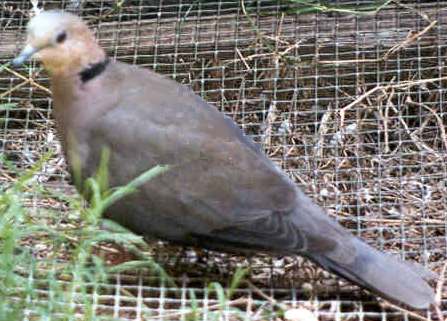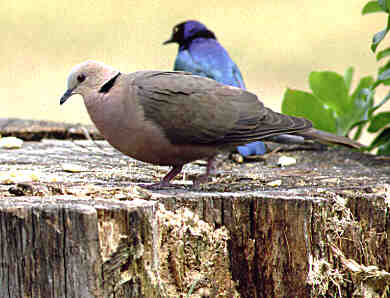
pic Jeff Downing
Red-eyed Dove
Streptopelia semitorquata
AKA: Half-collared Dove, Black Dove, Black
Pigeon
(latter two names used locally in distinction from other lighter colored doves)

pic Jeff Downing

©DHoestra

Lake Naivasha, Africa

©John Pire
Distribution: Africa, mainly found south of the Sahara & in south-western Arabia. In contrast to other Streptopelia species the red-eyed dove inhabits well wooded forests & well watered areas. Can also be found in lightly wooded & semi arid & humid areas of it's range. Is associated with clearings, forest edges along the rivers & human cultivation (Congo basin); in South Africa has adapted to parks & gardens in urban areas.
Description: (Ruppell 1837) Length 30 cm. the largest & darkest of all the African "ring-necked dove species". Nearly as large as a small feral pigeon. Forehead whitish or pale bluish grey shading to bluish grey on crown. Neck, breast dark mauve pink shading to bluish grey on belly, flanks & undertail coverts. A very thin whitish grey feather edging (only on sides of neck ring). The black neck ring narrows to almost meeting in the middle of the hind neck - creating two halves - hence the common name "Half-collared Dove". Upperparts and wing shields very dark dull chocolate brown, flight feathers blackish; bluish grey wing edge (bend); underwing, flanks & sides of rump bluish grey. Rump & uppertail coverts grey brown. Tail above shows outer third greyish brown, inner two thirds dark blackish brown; undertail silver grey on distal third - basal two thirds blackish. Bill black. Eye cere deep reddish purple; iris orange, yellowish, red or orange-brown (depending on area). Legs & feet reddish purple. Female very similar to male, sometimes by comparison may be duller overall. Juveniles much duller.
Subspecies: no recognized races, but individuals do vary in
the different regions of their habitat; size & coloration are main differences,
with the southern birds being smaller & duller in color.
NOTE: the first Red-eyed Doves in the 60's & 70's US did not have a pronounced
reddish purple eye cere. In the 80's a west coast zoo imported a shipment of
African birds & the Red-eyed Dove was among them. This was the source
for all Red-eyed Doves currently in US collections.
Distinctive light & dark pattern on tail "without any white areas". Easily confused with Mourning Collared Dove (Streptopelia decipiens). However, in the US this mistake is not likely since the Mourning Collared Dove is not found in any US collections (J Pire).
Nesting: two white eggs, incubation by both parents 14-17 days. Squabs fledge within two weeks, young are independent within another three weeks. Males can become aggressive during breeding periods.
Courting display: the bowing display, compared to the common Ringneck dove (Streptopelia risoria) is quicker and lower; at the end of the display the head is held at a different angle so that the pale forehead area presented & is seen by the female.
Voice: the advertising coo is loud - 6 to 8 coos - usually repeated several times. This same coo is used when nest calling, but uttered more times upwards of 40 times. The display coo is a faster, muffled version of the advertising call. This species also has the high pitched excitement scream; often heard when handled & trying to escape; also given when frightened or after mating.
Display flight: not seen in captive birds, but here in the US one can obtain an idea of what it looks like. The ECD (Eurasian Collared Dove has a very similar display flight. Most of the Streptopelia species have a towering upwards flight with some "wing clapping" on the upwards flight; the male then stalls at the peak of his ascent then begins a circular gliding descent with wings & tail outstretched finally coming to land on a tall perch. I never witnessed or heard the male Red-eyed Dove utter the "scream" as the male ECD sometimes does when landing after the display flight (personnel observations by J Pire).